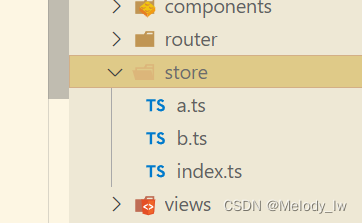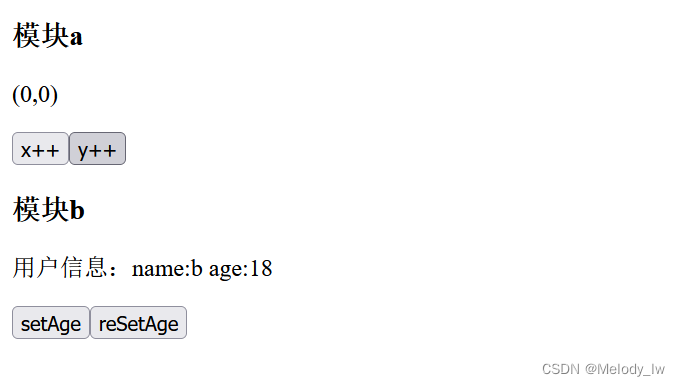vue pinia 全局状态管理
Melody_lw 人气:4与vuex的区别
去除了 mutation 选项。省去了复杂的disptach和commit流程,直接通过模块实例调用实例的actions中的方法即可触发对应action;在组件中直接可以通过模块实例的$patch修改store状态或者通过action来间接修改store状态。响应式数据原理是proxy,使得数据的增加或者删除字段都具备响应式。
安装
yarn add pinia
引入pinia
在main.ts中注册pinia插件
import {createPinia} from 'pinia' // vue3
// import {PiniaVuePlugin} from 'pinia' // vue2
const app=createApp(App)
app.use(createPinia())
app.mount('#app')
创建状态目录
在src下创建文件夹store,在store下创建文件index.ts,a.ts,b.ts。a.ts和b.ts分别是管理某个状态的模块,index.ts用来整合这些模块。

pinia模块组成
state、actions、getters。
创建pinia模块
对应选项的含义看代码注释。
1.在a.js编写如下代码
import {defineStore} from "pinia"
export default defineStore('a',{ // a是模块的命名空间,不能和其他模块的一样
state:()=>({ // state是一个函数,函数返回值为管理的状态
x:0,
y:0,
}),
})
2.在b.ts编写如下代码
import {defineStore} from "pinia"
export default defineStore('b',{
state:()=>({
name:'b',
age:18,
}),
actions:{
print(msg:string){ // 同步action
console.log(msg)
},
async setAge(newAge:number){ // 异步action
// 模拟接口
const setAgeReq=<T>(age:T)=>new Promise<T>((rel)=>{
setTimeout(()=>{rel(age)},1000)
})
const age=await setAgeReq(newAge)
// 在action中通过实例来直接修改状态
this.age=age
// 在action中也可以通过实例直接调用其他action
// this.print('age is be updated success')
}
},
getters:{
// 和vuex的getters一样,返回一个值就行了。和computed一样具有缓存机制
userInfo():string{
return `name:${this.name} age:${this.age}`
}
},
})
3.在index.ts中整合所有模块
import a from "./a"
import b from "./b"
export {
a,b
}
在组件中使用该状态机
pinia的api基本都在该案例中,注释和代码都很容易理解,相信小伙伴们都看的懂。如果不是很明白,可以看下一章节的api讲解,看懂的可以跳过api讲解章节。
<script setup lang='ts'>
// 引入pinia模块
import {a as useA ,b as useB} from "./store"
import {storeToRefs} from "pinia"
// 模块是一个函数,函数的返回值是模块的实例
const storeA=useA()
const storeB=useB()
/* 通过$patch直接修改store状态,$patch方法接收一个函数,函数的参数是该模块的状态
在这个函数中我们可以直接修改store状态*/
const addx=()=>{storeA.$patch((s)=>{s.x++})}
const addy=()=>{storeA.$patch((s)=>{s.y++})}
// 如果要解构使用状态需要使用该api进行转换,否则不具备响应式
const {x,y}=storeToRefs(useA())
// 通过action间接修改store状态
const setAge=()=>{
// 异步action返回promise。原理也很简单,async函数的返回值是promise
storeB.setAge(20).then(()=>{console.log('age is be updated success')})
}
// 通过 $subscribe监听状态的变更
storeB.$subscribe((c,s)=>{ // state变化时回调。有变化信息和状态两个参数
// console.log(c)
// console.log(s)
},{
detached:false, // 在组件卸载时是否继续监听
deep:true, // 是否深度监听
flush:'post', // post:组件更新后执行;sync:始终同步触发;pre:组件更新前执行
})
// 通过$onAction监听action的调用
storeB.$onAction((c)=>{ // 当调用action时回调
// console.log(c)
// c.after(()=>{console.log('after caller')}) //after的回调在该函数中最后执行
// console.log('action')
},false) // 为true时,组件卸载时也监听该行为
// 通过$reset重置对应模块的状态
const reSetAge=()=>{
storeB.$reset()
}
</script>
<template>
<h3>模块a</h3>
<p>({{storeA.x}},{{storeA.y}})</p>
<button @click="addx">x++</button>
<button @click="addy">y++</button>
<h3>模块b</h3>
<p>用户信息:{{storeB.userInfo}}</p>
<button @click="setAge">setAge</button>
<button @click="reSetAge">reSetAge</button>
</template>
运行结果:

pinia模块实例中的api讲解
1.获取模块实例
// 引入模块
import {a as useA ,b as useB} from "./store"
// 模块是一个函数,函数的返回值是模块的实例
const storeA=useA()
const storeB=useB()
2.提供实例修改对应模块的状态
i:直接修改
/* 通过$patch直接修改store状态,$patch方法接收一个函数,函数的参数是该模块的状态
在这个函数中我们可以直接修改store状态*/
const addx=()=>{storeA.$patch((s)=>{s.x++})}
const addy=()=>{storeA.$patch((s)=>{s.y++})}
ii:间接修改
import {storeToRefs} from "pinia"
// 如果要解构使用状态需要使用该api进行转换,否则不具备响应式
const {x,y}=storeToRefs(useA())
3.状态的解构使用
import {storeToRefs} from "pinia"
// 如果要解构使用状态需要使用该api进行转换,否则不具备响应式
const {x,y}=storeToRefs(useA())
4.监听状态的变更
// 通过 $subscribe监听状态的变更
storeB.$subscribe((c,s)=>{ // state变化时回调。有变化信息和状态两个参数
// console.log(c)
// console.log(s)
},{
detached:false, // 在组件卸载时是否继续监听
deep:true, // 是否深度监听
flush:'post', // post:组件更新后执行 ,sync:始终同步触发 ,pre:组件更新前执行
})
5.监听action的触发
// 通过$onAction监听action的调用
storeB.$onAction((c)=>{ // 当调用action时回调
// console.log(c)
// c.after(()=>{console.log('after caller')}) //after的回调在该函数中最后执行
// console.log('action')
},false) // 为true时,组件卸载时也监听该行为
6.重置状态
// 通过$reset重置对应模块的状态
const reSetAge=()=>{
storeB.$reset()
}
7.注册插件
import {createPinia} from 'pinia'
// plugin是一个函数
createPinia().use(Plugin)
状态持久化
这里需要使用到注册插件的功能。首先在src/plugins/pinia/persistence.ts中编写如下代码
import {PiniaPluginContext} from 'pinia'
import {toRaw } from 'vue'
// 封装pinia持久化插件。执行时机:store初始化时,执行次数是模块的次数
export default function(type:'localStorage' | 'sessionStorage'){
return (ctx:PiniaPluginContext)=>{
// console.log(ctx)
// const {app,options,pinia,store}=ctx
/*
app:vue应用 ;options:导出pinia模块的选项
pinia:pinia app ; store:pinia的store实例
*/
const store= ctx.store // 每次执行时的store是关于那个模块的store
const storeWay=type==='localStorage'?localStorage:sessionStorage
// console.log(store)
store.$subscribe(()=>{
// console.log(toRaw(store.$state))
storeWay.setItem('pinia_'+store.$id,JSON.stringify(toRaw(store.$state)))
},{deep:true})
// return的值为store初始状态。pinia处理过了,如果为retrun为null使用模块的初始值,
return JSON.parse(storeWay.getItem('pinia_'+store.$id) as any)
}
}
然后在mian.js编写如下代码即可。此时刷新浏览器刷新时,状态是可以保持的,不会被重置。
import { createApp} from 'vue'
import App from './App.vue'
import {createPinia} from 'pinia'
// import {PiniaVuePlugin} from 'pinia' // vue2
import persistence from "./plugins/pinia/persistence"
const app=createApp(App)
// app.use(createPinia().use(persistence('sessionStorage'))) //sessionStorage方式持久化
app.use(createPinia().use(persistence('localStorage'))) //localStorage方式持久化
app.mount('#app')
加载全部内容